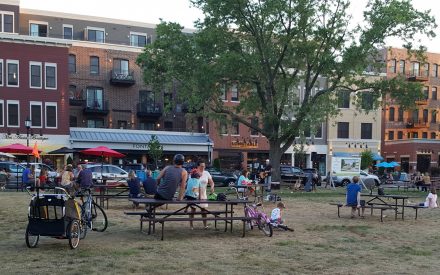Home » Programs » Downtown Toolbox » Example Consumer Survey Questionnaire
Example Consumer Survey Questionnaire
Once you have selected a survey technique or techniques, you must determine what questions you want to ask. Because respondents will only be willing to spend a limited amount of time, any survey must only ask the most important questions. We provide a variety of general categories of questions specific to a downtown consumer survey questionnaire.
General Categories for Consumer Survey Questionnaires
Retail Shopping Categories
We provide a variety of general categories of questions specific to retail shopping to help you think through the areas you may want to consider:
Preference for Shopping Location
- We want to know where people shop in the community and why.
Characteristics of a Positive Shopping Experience
- We want to know the shopping district with the most positive shopping characteristics.
- We want to know the shopping mall/center with the most positive shopping characteristics.
Shopping Event Specifics
- We want to know when shoppers typically shop (e.g. day, time, duration).
- We want to know where shoppers most often shop.
Suggestions for Improving the Shopping Experience
- We want to know what shoppers would suggest improving the experience.
- We want to know the degree to which the suggested changes might encourage shoppers to shop more in the area.
- We want to know what potential shoppers believe to be desirable retailers for the area.
- We want to know where shoppers would prefer such new businesses to be located.
Advertising/Marketing
- We want to know what types of advertising shoppers notice the most.
- We want to know the extent to which the types of advertising influence decisions about where shoppers choose to shop.
Downtown Use Categories
General categories of questions that go beyond retail shopping and address a mixture of downtown uses are listed below along with a sample of questions for each.
When, Where, and Why They Go Downtown
- When do they typically shop for non-grocery items?
- During which extended hours they are most likely to shop for non-grocery items?
- How often do they eat breakfast, lunch, or supper out?
- What restaurants or types of cuisine they would most like to see come downtown?
- How often do they watch movies at a theater or rent movies to watch at home?
- Which events have they attended in the last 12 months?
- How often do they come downtown?
- What are the biggest non-work reasons for them to stop downtown?
- Where do they typically park when they drive downtown?
- How far do they live from downtown?
- Where they are more likely to shop for non-grocery items: near where they work or live?
- How often do they shop at competing locations/stores and for what reasons?
What They Want Downtown
- What businesses they would most like to see come downtown?
- Which community assets would they most like to see developed?
- Have they ever lived downtown or have an interest in living there?
- What is their opinion about someday living downtown?
- What type of downtown housing and housing amenities would they prefer?
- If they moved (or stayed) downtown, what size housing unit would they require?
Demographic Categories
Demographic, Market, and Marketing Data
- Their gender
- Their age
- By age, how many people live in their household
- Their home zip code
- Their marital status
- The highest level of formal education they have completed
- Their household’s annual income
- Which leisure activities their household participates in
- What radio stations do they listen to most
- What publications do they read most
- Their level of interest in starting their own business
- Their attitudes about the downtown and the community
Consumer Survey Questionnaires
Wisconsin Main Street Program's Standardized Written Consumer Survey
The Wisconsin Main Street Program’s Standardized Written Consumer Survey includes 39 questions in the following categories:
- When, Where and Why They Shop – Questions 1-17
- What They Want – Questions 18-26
- Market and Marketing Data – Questions 27-39
General Downtown Survey for Superior, WI as prepared by the University of Wisconsin-Madison, Extension
Customized and shortened adaptations of the Wisconsin Main Street Program’s Standardized Written Consumer Survey provide additional examples for your use. The sample survey instrument that follows may include some additional questions not in the Wisconsin standardized survey.
Example of Administrating a Consumer Survey
The best way to ensure the successful administration of any project, including a written consumer survey, is to develop and follow a work plan. Below are tasks identified for a hypothetical written survey work plan. Many of the steps presented here assume that you are using the Standardized Written Consumer Survey developed by the Wisconsin Main Street Program.
Step 1. Review Examples from Other Communities
Many communities have administered a written consumer survey and most are more than happy to share their methods and results. There is little advantage in trying to design your written consumer survey from scratch. If your community is like most, you will lack volunteers with significant survey experience. It is easy to make costly mistakes. If a question is worded incorrectly it will make the answers collected less useful.
In order for answers to be useful, questions must be unambiguous and should not lead the respondent to a particular response. For easier analysis and interpretation, to the extent possible ask multiple choice rather than open-ended questions. Also, ask about existing behavior since existing behavior is the best predictor of future behavior. Match questions on demographics with census categories so that they can be compared. Even subtle differences in the wording of similar questions found on surveys from two different communities will prevent comparisons between those two communities. This is not meant to discourage you from administering your own written consumer survey but to encourage you to be cautious when writing questions.
Step 2. Accept/Reject Standardized Questions
The Standardized Written Consumer Survey provided as an appendix includes questions that the Wisconsin Main Street Program staff believe to be important in a comprehensive downtown market analysis and useful for each point of the Main Street Four-Point Approach; design, organization, promotion and economic restructuring. You are free to eliminate entire questions that are less important to your immediate efforts in order to shorten the survey.
When accepting or rejecting standardized questions, keep in mind that some of the questions in the Standardized Written Consumer Survey are designed to be used together with questions from the Standardized Business Owner Written Survey. The paired questions allow for comparisons between the perceptions, attitudes and behaviors of potential customers and business owners.
Shorter or simpler surveys such as intercept and phone surveys can use a smaller set of questions often selected from the mail survey set. If an intercept survey is conducted, ask additional questions that capture thoughts fresh in the minds of shoppers. Base added questions on their current shopping trip, such as what they intended to purchase vs. what was actually purchased.
Step 3. Draft Customized Questions
Always customize any borrowed survey to fit your unique local needs.
Step 4. Draft Introduction
An introduction is an important part of all survey techniques. For mail surveys the introduction will be presented through a cover letter. For intercept surveys, phone surveys and focus groups the introduction will be presented verbally. The introduction should briefly explain the purpose of the survey and for whom it is being done. It should then explain to the resident that they were selected randomly or, in the case of focus groups, because they are a member of a specific group. It should also give them an estimate of the amount of time required and ask if they are willing to help.
Step 5. Proofread and Pretest Your Survey
It is always good practice to proofread and pretest your survey, including your cover letter, before full distribution. Sometimes volunteers drafting the customized questions get too close to their work and fail to see the obvious. Have a few volunteers who are active in your organization, but who have not been involved in survey design, take your written consumer survey and give you feedback. Instructions and questions that are unclear and misinterpreted will show up in a pretest and can be corrected.
Step 6. Approve Final Survey
Eventually editing must come to an end. Because distribution and collection requires a significant commitment of volunteer and financial resource it is important to have the organization or committee overseeing the project formally approve the final version of your written consumer survey.
Step 7. Answer Sampling Questions
Once you have completed your survey instrument, you must decide who you want to answer your questions. For mail and telephone surveys, a random sample is best to ensure the sample reflects the demographic makeup of the trade area. In order to develop a sampling plan for your survey, you must first answer the following questions:
- What is the minimum number of completed surveys that you require?
- What is your expected response rate?
- What is your available budget?
- What is your available workforce?
For example, if you need to collect at least 400 completed surveys to reach a 95% degree of certainty that your sample represents the trade area population, you would need to calculate how many surveys you need to send. You can calculate the number of surveys you will need to print and distribute based on the following equation:
# of surveys distributed = required minimum number returned ¸ expected response rate
For example, if you target the minimum of 400 completed surveys and expect a response rate of 30% your calculation would be as follows:
400 ¸ .30 = 1333 surveys distributed
Step 8: Develop and Promote your Survey Plan
Your financial and human resources will determine the best way to distribute the surveys. For mail surveys, consider sending the survey directly to a random sample of addresses. For phone surveys, consider randomly calling names from the phone book. For intercept surveys, randomly select downtown users at strategic locations, dates and times of day. For example, select every tenth person that walks by your selected location. Be sure to explore opportunities for corporate sponsorship to defray postage and printing costs.
To stay on task, you must set dates for distributing and returning your written consumer survey and assign specific responsibilities. It is recommended that all survey plans be thoroughly promoted in area newspapers and radio and TV stations prior to carrying out the survey. Potential respondents will be much more likely to participate if they understand the project and why it will help the community. Be sure to publicly thank your financial sponsors.
Step 9. Print Survey
The number of respondents you plan to survey will affect your printing decisions. Photocopying surveys is more cost effective for low volumes while professional printing is more cost effective for high volumes. If photocopying, make sure the quality of the copy is good. Stray marks that sometimes show up on poor copies could affect the accuracy of computerized optical mark recognition software (if you are using this method).
Step 10. Distribute Surveys
The printed surveys from Step 9 need to be delivered according to the plan from Step 8.
Step 11. Collect Surveys
Collecting mail surveys involves providing a means to return the completed survey. This can include using a self-addressed form or envelope with prepaid postage so they can mail it back or having drop-boxes available throughout the community. For intercept surveys, phone surveys and focus groups collecting involves recording their answers. While collecting, be careful not to sway the opinion of the respondents. Be clear at all times and consistent with all respondents. When possible, consider offering incentives for participation to improve response rates. Finally, thank the respondents at the end.
Step 12. Enter Surveys
Once survey responses are collected, enter the data into a spreadsheet or database program.
Step 13. Verify Data and Enter Open Ended
While most computerized optical mark recognition software is surprisingly accurate, there are always answers that will be unrecognized or incorrectly recorded. In addition, most programs are still unable to automatically recognize handwriting and open-ended responses. For these reasons it is necessary for someone, preferably a volunteer, to verify and correct the accuracy of scanned answers and to type open-ended answers.
Step 14. Review Raw Data
Once the data is entered it is relatively straightforward to report the frequency of each response to each question.
Step 15: Summarize/Interpret Data
Later, sort and create demographic or lifestyle groups of the respondents. For each group, use “cross tabulations” of the data to reveal their shopping habits and views of the downtown. For telephone and mail surveys, it is important to check the randomness of the sample selected by comparing their demographic characteristics with data for the entire trade area (see Analyzing Customer Demographics and Lifestyle section). The overall household income, age, gender, and other characteristics of those surveyed should parallel the percentages for the entire trade area.
The questions in the surveys will cover a variety of uses downtown including retail, dining, housing, and others. In analyzing the results by consumer group, keep in mind some of the fundamental questions your survey is attempting to answer:
- Which consumer groups go or use downtown the most?
- What are their preferences, likes and dislikes?
- Are their consumer needs and wants being met?
- Are there opportunities for downtown to serve these consumers more effectively?
- How can downtown business and building owners improve their capture of the market?
- What promotional methods are most effective?
- What physical aspects of the downtown should be improved?
The survey results should provide existing businesses and building owners with detailed answers to these and other questions. The information can be put to work immediately to improve business operations and marketing efforts. Survey responses will also be used in later sections of this market analysis guidebook to examine specific business and real estate opportunities. In these sections, your written consumer survey findings will be combined with various secondary data sources to more accurately assess business expansion and recruitment possibilities.
Step 16. Print Summary
Human and financial resources should be directed toward quality editing not expensive printing.
Step 17. Distribute Summary
Remember to share the results of your survey with the community and your existing business owners. Develop a press release summarizing the results to generate interest and coverage by your local media. Mail or hand-deliver the summary report to existing business owners. Sharing this information is an important business retention activity. The report will demonstrate ways they might personally benefit from the results in the future.
About the Toolbox and this Section
The 2022 update of the toolbox marks over two decades of change in our small city downtowns. It is designed to be a resource to help communities work with their Extension educator, consultant, or on their own to collect data, evaluate opportunities, and develop strategies to become a stronger economic and social center. It is a teaching tool to help build local capacity to make more informed decisions.
This free online resource has been developed and updated by over 100 university educators and graduate students from the University of Wisconsin – Madison, Division of Extension, the University of Minnesota Extension, the Ohio State University Extension, and Michigan State University – Extension. Other downtown and community development professionals have also contributed to its content.
The toolbox is aligned with the principles of the National Main Street Center. The Wisconsin Main Street Program was a key partner in the development of the initial release of the toolbox. One of the purposes of the toolbox has been to expand the examination of downtowns by involving university educators and researchers from a broad variety of perspectives.
The current contributors to each section are identified by name and email at the beginning of each section. For more information or to discuss a particular topic, contact us.
















